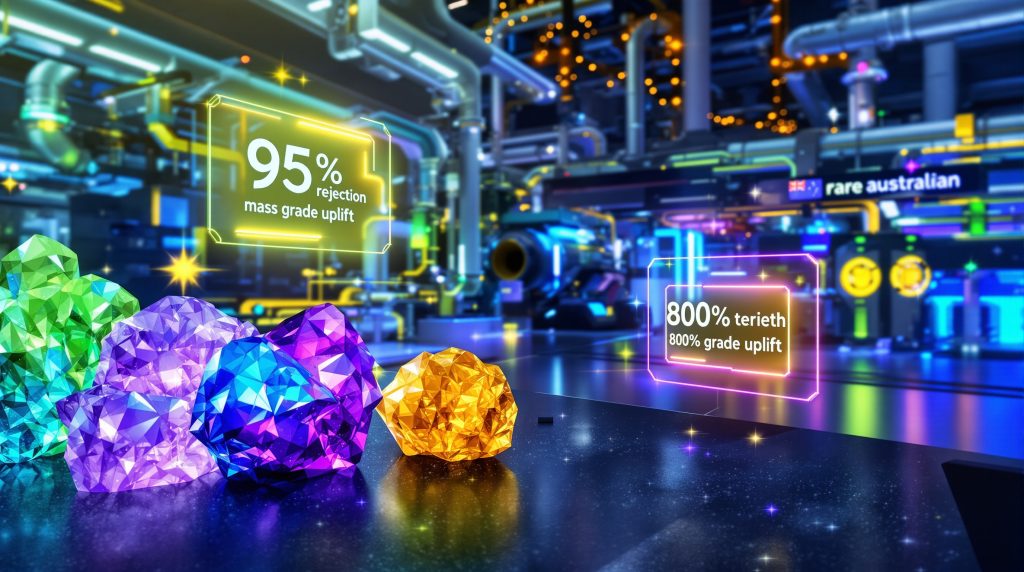Advanced Rare Earths Beneficiation: Critica's Pilot Plant Innovation
Rare earth elements are essential components in modern technology, from electric vehicles to wind turbines. However, traditional processing methods are often expensive, reagent-intensive, and environmentally challenging. Critica's new pilot-scale beneficiation plant represents a significant step forward in addressing these challenges through innovative physical separation technologies that substantially reduce processing costs and environmental impact.
What is Critica's Rare Earths Beneficiation Pilot Plant?
Located in Hanoi and operated by the Centre for Science and Technology of Mineral and Environment (GAVAQ), Critica's closed-circuit beneficiation pilot plant represents a technological breakthrough in rare earth processing. The facility will process a 3000kg bulk sample from Critica's Jupiter project in Western Australia, validating bench-scale results that demonstrated approximately 95% mass rejection with more than 800% grade uplift in rare earth concentrates.
This pilot-scale facility is designed to generate high-grade rare earth intermediate concentrate through advanced physical separation methods. By implementing these techniques before chemical processing, Critica aims to dramatically reduce the scale and cost of downstream operations while minimizing environmental impact.
Jacob Deysel, Critica's CEO, describes the pilot plant as "a key step on the company's 'Scale, Simplicity, Speed' roadmap" that will deliver critical data for the project's scoping study and support discussions with potential offtake partners.
The pilot plant's closed-circuit design enables precise control of processing parameters while maximizing recovery rates. This controlled environment allows engineers to optimize each stage of the beneficiation process, from initial crushing through to final concentration.
How Does Beneficiation Transform Rare Earth Processing?
The Technical Foundations of Rare Earth Beneficiation
Beneficiation encompasses various physical separation processes that upgrade ore before more intensive chemical processing begins. For rare earths, this typically follows a multi-stage approach:
- Crushing and grinding: Breaking down the ore to liberate valuable rare earth minerals from waste rock
- Gravity separation: Utilizing density differences to separate heavier rare earth minerals from lighter gangue materials
- Magnetic separation: Exploiting the paramagnetic properties of many rare earth minerals to concentrate them
- Flotation techniques: Using surfactants and air bubbles to selectively separate valuable minerals
These methods work synergistically to concentrate the valuable rare earth content while rejecting waste materials early in the processing chain, dramatically reducing the volume of material requiring chemical treatment.
The effectiveness of these techniques varies depending on the mineralogy of the deposit, which makes pilot-scale testing crucial for validating the specific mineral beneficiation insights for each unique ore body.
Advantages of the "Beneficiation-First" Approach
The beneficiation-first strategy pioneered by Critica represents a paradigm shift in rare earth processing, offering several substantial advantages:
| Processing Parameter | Without Beneficiation | With Beneficiation | Improvement |
|---|---|---|---|
| Plant Size Requirement | Larger processing facilities | Up to 95% smaller leach plant | Reduced footprint |
| Reagent Consumption | Higher chemical usage | Significantly reduced | Lower environmental impact |
| Grade of Feed Material | Lower (raw ore grade) | 8x higher concentrate grade | More efficient processing |
| Capital Expenditure | Higher initial investment | Potentially lower CAPEX | Improved project economics |
| Operating Costs | Higher ongoing expenses | Reduced OPEX | Enhanced profitability |
By rejecting approximately 95% of waste material before chemical processing begins, the beneficiation-first approach significantly reduces the required size of the hydrometallurgical plant. This translates to lower capital requirements, reduced reagent consumption, and decreased waste management costs.
Deysel emphasizes that this approach "translates to a smaller leach plant, lower reagent use and a cleaner, faster path to MREC (Mixed Rare Earth Carbonate)." This efficiency gain is particularly important for rare earth projects, which often face challenging economics due to complex processing requirements.
The environmental benefits are equally significant. Reduced reagent usage means fewer chemicals requiring management and disposal, while the smaller plant footprint minimizes land disturbance and habitat impact. This aligns with growing regulatory and market pressures for more sustainable mining practices.
What Makes the Jupiter Project Significant?
Location and Resource Characteristics
The Jupiter rare earths project is strategically located approximately 250km east of Geraldton in Western Australia. This location provides several advantages:
- Proximity to established transportation infrastructure
- Access to Western Australia's skilled mining workforce
- Operation within Australia's stable and supportive mining jurisdiction
- Potential connection to export facilities for international markets
Western Australia has emerged as a significant player in the global rare earths sector, with favorable geology and a progressive approach to critical minerals strategy. The state government has identified rare earths as strategic resources, implementing policies to encourage responsible development.
The project's geological characteristics make it particularly amenable to the beneficiation-first approach, with mineralogy that responds well to physical separation techniques. This natural advantage amplifies the potential benefits of Critica's innovative processing strategy.
Dual Development Strategy
Critica is advancing the Jupiter project through two parallel workstreams, maximizing efficiency and reducing overall development timelines:
-
Geological Optimization
- Comprehensive resource definition through strategic drilling programs
- Detailed infill drilling to improve confidence levels and resource classification
- Advanced block modeling with particular focus on magnet rare earth zones
- Reserve estimation and mine planning for optimal extraction sequences
-
Metallurgical Advancement
- Rigorous beneficiation process development and optimization
- Pilot plant validation of key processing parameters
- Integrated flowsheet development for commercial implementation
- Scale-up testing through the GAVAQ collaboration
This dual-track approach allows for simultaneous progress on multiple fronts, potentially accelerating the overall project timeline. By addressing geological and metallurgical aspects in parallel rather than sequentially, Critica aims to reduce the time from discovery to production.
The focus on magnet rare earths is particularly strategic, as elements like neodymium, praseodymium, dysprosium, and terbium command premium prices due to their critical role in permanent magnet production for electric vehicles and wind turbines.
What Technical Objectives Will the Pilot Plant Achieve?
Key Performance Indicators
The pilot plant is designed to validate several critical performance metrics that will inform the project's future development:
- Confirmation of 95% mass rejection capabilities at scale
- Verification of 800% grade uplift in concentrate under continuous operation
- Assessment of tailings characteristics for environmental planning and management
- Determination of optimal process parameters for full-scale operations
- Evaluation of reagent consumption and recovery efficiencies across various ore types
These performance indicators will provide crucial data on both the technical and economic viability of the beneficiation approach. By processing a substantial 3000kg bulk sample, the pilot plant will generate statistically significant results that can be reliably scaled to commercial operations.
The data on tailings characteristics is particularly important for environmental planning, as it will inform waste management strategies and rehabilitation approaches. This proactive environmental assessment reflects the industry's growing focus on responsible resource development.
Data Collection for Project Advancement
Results from the pilot plant will directly support several critical project development activities:
- Comprehensive scoping study development and economic modeling
- Downstream processing testwork at specialized facilities including ANSTO and Minutech
- Detailed feasibility assessment and project financing discussions
- Environmental impact evaluations and permitting applications
- Offtake discussions with potential customers in the rare earth supply chain
The bulk concentrate produced during pilot operations will enable advanced testing of downstream processing options, including hydrometallurgical treatments to produce Mixed Rare Earth Carbonate (MREC). This testing will help optimize the entire processing chain from mine to marketable product.
By generating "decision-grade data" as described by CEO Deysel, the pilot plant will provide the technical foundation for key project advancement decisions, potentially accelerating the development timeline.
How Does This Fit Into Critica's Strategic Roadmap?
The "Scale, Simplicity, Speed" Approach
Critica's CEO Jacob Deysel has articulated a strategic roadmap built around three core principles:
- Scale – Demonstrating process viability at increasingly commercial volumes, from laboratory to pilot to full production
- Simplicity – Developing straightforward, efficient processing routes that minimize complexity and operational risk
- Speed – Accelerating project development timelines through parallel workstreams and strategic partnerships
This approach reflects a sophisticated understanding of the rare earth market, where project economics can be challenging and speed to market provides competitive advantage. By focusing on these three principles, Critica aims to overcome the traditional hurdles that have slowed rare earth project development.
The pilot plant represents a key milestone in scaling up from bench-scale testing to commercial operations. This intermediate step is crucial for de-risking the technology while optimizing process parameters before committing to full-scale production.
Pathway to Mixed Rare Earth Carbonate (MREC) Production
The pilot plant will produce bulk concentrate for further testing at specialized facilities including:
- ANSTO (Australian Nuclear Science and Technology Organisation) – Australia's premier nuclear science and technology organization with extensive experience in rare earth processing
- Minutech – A metallurgical consultancy with specialized expertise in rare earth extraction and purification
These partnerships will help refine the pathway to producing MREC, a valuable intermediate product in the rare earth supply chain. MREC represents a crucial step between mine output and separated rare earth elements, offering greater value than raw concentrate while avoiding the massive capital costs of full separation facilities.
The focus on MREC production represents a pragmatic approach to market entry, allowing for revenue generation without the enormous capital expenditure required for rare earth separation facilities. This strategy aligns with industry trends toward more distributed supply chains with specialized participants.
What Are the Economic Implications of Advanced Beneficiation?
Cost Reduction Potential
Successful implementation of the beneficiation-first approach could significantly impact project economics through multiple mechanisms:
- Capital cost reductions: Smaller hydrometallurgical plant requirements translate to lower upfront investment
- Operating cost improvements: Lower reagent consumption and reduced processing volumes decrease ongoing expenses
- Waste management savings: Less material requiring chemical treatment means reduced waste handling and storage costs
- Accelerated timeline benefits: Potentially faster time to market improves project net present value
- Scaling advantages: Lower capital intensity enables more flexible production scaling
These economic benefits could transform the viability of rare earth projects that might otherwise struggle to achieve commercial returns. The rare earth sector has historically faced challenging economics due to complex processing requirements and high capital costs.
For investors and project developers, these improvements could significantly enhance project returns and reduce financial risk. The potential for lower capital intensity is particularly important in the current high-interest-rate environment, where capital efficiency is paramount.
Market Positioning
By focusing on high-grade concentrate production, Critica positions itself strategically within the rare earth market:
- Premium product potential: Higher-grade concentrates may command better terms from refiners
- Logistics advantages: Reduced shipping volumes through significant mass rejection
- Environmental differentiation: Smaller environmental footprint may appeal to ESG-focused customers
- Processing flexibility: Multiple potential pathways for further value addition
- Market adaptability: Ability to adjust production to target highest-value rare earth elements
This positioning reflects an understanding of the evolving rare earth market, where sustainability credentials and supply chain security are increasingly important to customers, particularly in the automotive and renewable energy sectors.
The ability to produce higher-grade concentrates also opens possibilities for specialized applications that require specific rare earth compositions, potentially accessing premium market segments beyond commodity-grade products.
How Does This Technology Compare to Traditional Processing?
Conventional vs. Beneficiation-First Approaches
The beneficiation-first approach represents a significant departure from conventional rare earth processing methods:
| Processing Aspect | Conventional Approach | Beneficiation-First Approach |
|---|---|---|
| Initial Processing | Direct leaching of raw ore | Physical separation before leaching |
| Material Handling | Large volumes throughout process | Significantly reduced volumes after beneficiation |
| Chemical Consumption | Higher reagent usage | Lower reagent requirements |
| Environmental Impact | Larger waste footprint | Reduced chemical waste generation |
| Capital Requirements | Higher processing plant costs | Potentially lower overall CAPEX |
| Operational Complexity | More complex chemical management | Simplified downstream processing |
Conventional rare earth processing typically begins with aggressive chemical leaching of raw ore, requiring large quantities of acids or other reagents to dissolve the rare earth content. This approach processes the entire ore volume, including waste material, resulting in high reagent consumption and significant waste generation.
In contrast, the beneficiation-first approach uses physical methods to concentrate the valuable minerals before chemical processing begins. By rejecting up to 95% of waste material early in the process, this approach dramatically reduces the volume requiring chemical treatment, with corresponding reductions in reagent use and waste production.
This comparison highlights the potential for beneficiation to address many of the environmental and economic challenges that have historically limited rare earth production outside China. By fundamentally changing the processing approach, companies like Critica are working to establish more sustainable and economically viable rare earth supply chains.
What Challenges Must Be Overcome?
Technical Considerations
Despite the promising approach, several technical challenges must be addressed for successful implementation:
- Mineralogical variability: Ensuring consistent recovery rates across different ore types and zones
- Scale-up factors: Accounting for efficiency differences between pilot and commercial operations
- Recovery optimization: Balancing maximum recovery with concentrate grade requirements
- Process integration: Seamlessly connecting beneficiation with downstream hydrometallurgical processing
- Equipment selection: Identifying optimal equipment configurations for commercial implementation
These technical challenges require rigorous testing and optimization, which is precisely the purpose of the pilot plant. By processing a substantial bulk sample under controlled conditions, Critica will generate the data needed to address these considerations.
The mineralogical variability challenge is particularly important, as rare earth deposits often contain multiple ore types with different beneficiation responses. Developing a robust process that can accommodate this variability is crucial for commercial success.
Implementation Timeline
The pilot plant represents a critical step in project development, but several phases remain before commercial production:
- Pilot operation phase (current): Processing 3000kg bulk sample and collecting comprehensive performance data
- Process optimization: Refining parameters based on pilot results to maximize efficiency
- Scoping study completion: Incorporating pilot findings into technical and economic assessments
- Detailed engineering: Designing commercial-scale facilities based on validated processes
- Construction and commissioning: Building and starting up full-scale operations
This timeline reflects the methodical approach required for responsible project development. While the beneficiation-first approach may accelerate certain aspects of the process, thorough testing and validation remain essential for project success.
Industry experts suggest that this phased approach, while requiring patience, ultimately reduces project risk and improves the likelihood of commercial success. The data-driven progression from pilot to commercial scale provides confidence to investors, regulators, and potential customers.
FAQ: Rare Earth Beneficiation Technology
What makes rare earth processing particularly challenging?
Rare earth elements typically occur in complex mineral structures at relatively low concentrations, often less than 10% of the total ore mass. Traditional processing requires aggressive chemical treatments to dissolve and separate these elements, generating significant volumes of waste and consuming large quantities of reagents.
Additionally, rare earths frequently occur alongside radioactive elements like thorium and uranium, creating additional processing and waste management challenges. Beneficiation helps address these issues by concentrating valuable minerals before chemical processing begins, reducing the volume of material requiring intensive treatment.
How does beneficiation impact environmental considerations?
By rejecting approximately 95% of waste material early in the process, beneficiation significantly reduces the environmental footprint of rare earth production:
- Reduced chemical usage: Less material requires chemical treatment, lowering reagent consumption
- Decreased waste generation: Smaller volumes of chemically-treated material result in less hazardous waste
- Lower water requirements: Reduced processing volumes translate to decreased water consumption
- Smaller land disturbance: Compact processing facilities and waste storage areas minimize habitat impact
- Energy efficiency improvements: Processing smaller volumes requires less energy throughout the value chain
These environmental benefits align with growing regulatory and market pressure for more sustainable mining practices. As consumers and investors increasingly prioritize environmental performance, technologies that reduce impact gain competitive advantage.
What is MREC and why is it important?
Mixed Rare Earth Carbonate (MREC) is an intermediate product in rare earth processing that contains concentrated rare earth elements in a carbonate form. This product represents a crucial step between mine output and separated rare earth oxides or metals.
MREC is important for several reasons:
- It provides a stable, transportable form of rare earths with significantly higher value than raw concentrate
- It requires much less capital investment to produce than fully separated rare earth products
- It offers a practical entry point into the rare earth market without building separation facilities
- It can be sold to existing separation facilities in the global supply chain
- It represents a more environmentally responsible approach than shipping minimally processed ore
By focusing on MREC production, companies like Critica can establish commercial operations more quickly and with lower capital requirements than attempting to build integrated separation facilities, which can cost billions of dollars.
How does this technology impact the global rare earth supply chain?
Advanced beneficiation technologies could enable more diverse sources of rare earth production by improving the economics of previously marginal deposits. This diversification has several important implications:
- Supply security enhancement: Reducing dependence on any single source or region
- Sustainability improvements: Enabling lower-impact production methods across the industry
- Cost competitiveness: Allowing new entrants to compete more effectively in the global market
- Technology transfer: Accelerating innovation across different mining jurisdictions
- Market rebalancing: Potentially reducing price volatility through more diverse supply
For critical applications like electric vehicles, wind turbines, and defense systems, a more resilient supply chain reduces risks and supports continued growth. Western nations have identified rare earth supply diversity as a strategic priority, creating policy support for projects employing innovative mining innovation trends and CRM facility developments.
Further Exploration:
Readers interested in learning more about rare earth processing technologies and mining developments in Australia can explore related content from Australian Mining, which offers perspectives on critical mineral developments across the Australian resources sector. The Western Australian government also provides resources on critical minerals development and regulatory frameworks supporting sustainable mining practices.
Disclaimer: This article discusses developing technologies and project economics that involve inherent uncertainties. Actual results may vary from projected performance metrics. Investment decisions should be based on comprehensive due diligence beyond the information presented here.
Ready to Invest in the Next Major Mineral Discovery?
Gain instant alerts on significant ASX mineral discoveries with Discovery Alert's proprietary Discovery IQ model, turning complex mineral data into actionable insights that give you a market-leading edge. Explore why historic discoveries generate substantial returns by visiting the Discovery Alert discoveries page and begin your 30-day free trial today.




